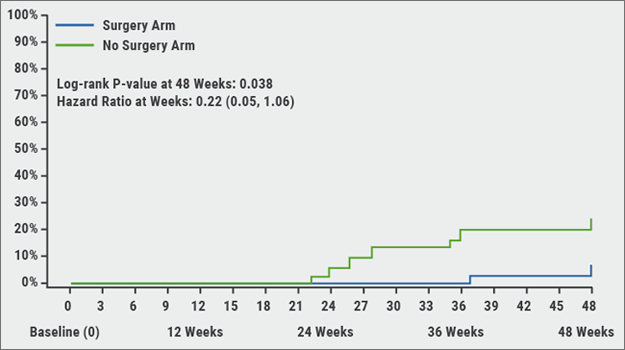“Acute exacerbation of chronic obstructive pulmonary disease (AECOPD) is a heterogeneous disorder; it is not a single entity but made up of many different conditions,” stated Prof. Don D. Sin (University of British Columbia, BC, Canada) [1]. They can be grouped by infectious aetiologies resulting from bacterial and/or viral triggers (50–60%) and non-infectious aetiologies such as pulmonary embolism or a lack of compliance. C-reactive protein (CRP) and N-terminal-prohormone of brain natriuretic peptide (NT-proBNP) are the most commonly investigated biomarkers for AECOPD. Nonetheless, even when combined they only achieved 0.8 AUC for discriminating AECOPD from other causes for respiratory distress in COPD patients [2]. For the same purpose, D-dimers have also been tested without providing enough resolution for clinical use, but this biomarker has proved itself valuable for ruling out pulmonary embolism [1]. Using a D-dimer threshold of 500 µg/L demonstrated that over a 3-month period patients below the threshold had a 0.94% risk of venous thromboembolism, whereas the risk of patients with ≥500 µ/L D-dimers was 9.4% [3]. CRP, on the other hand, is interesting to guide antimicrobial therapy. In the outpatient setting, the CRP-based decision-making for or against antimicrobial treatment led to ~20% absolute reduction in the use of antibiotics, compared with the usual approach that is based on clinical appearance [4]. CRP as guidance for antibiotic therapy of AECOPD in the hospital setting also entailed significantly fewer treatments with antibiotics than the Global Initiative for Chronic Obstructive Lung Disease (GOLD)-guided decision-making [5]. In light of these results, it was advocated that the case definition for AECOPD should be altered to become more objective by including values for dyspnoea worsening, oxygen desaturation, and lab results such as CRP, neutrophils, or eosinophils [6]. As the great majority of AECOPD have infectious causes, markers to phenotype the drivers are necessary as well [1].
Lung microbiome: a promising future tool to identify patients with poor prognosis?
Currently, it is known that even in healthy persons the lungs are not sterile. Moreover, molecular testing techniques such as 16S sequencing are used increasingly for pathogen identification. An investigation of the microbiome of the sputum of AECOPD patients at day 1 of hospital admission by 16S rRNA gene sequencing demonstrated that the microbiome profile may identify patients with poor prognosis [7]. The hazard of mortality within 1 year was higher in those who were missing Veillonella, a normal commensal in oropharynx and lungs, higher for those positive for Staphylococcus, and highest for patients Veillonella-negative and Staphylococcus-positive versus patients positive for Veillonella and negative for Staphylococcus. Furthermore, the diversity in the microbiome of survivors was greater than in that of non-survivors.
Concerning virus identification, Prof. Sin also saw future potential: “Going forward, we will have more molecular testing for viruses available to us and we do not have to just say the AECOPD was caused by a virus; we can identify the exact virus that was responsible for the AECOPD and develop a more targeted therapy to that virus.
Prof. Sin summarised: “Biomarkers are urgently needed to segregate the aetiologies into various categories for targeted therapy. Currently, CRP and D-dimers have the most promise. In the future, nevertheless, more molecular testing will be available to phenotype AECOPD and develop targeted therapy.”
- Sin DD. Biomarkers for Acute Exacerbations: Challenges and Promise. Session B027: Phenotyping acute exacerbations of COPD. ATS 2021 International Conference, 14-19 May.
- Chen YWR, et al. PLoS One 2017;12(3):e0174063.
- Couturaud F, et al. JAMA. 2021;325(1):59-68.
- Butler CC, et al. N Engl J Med. 2019;381(2):111-120.
- Prins HJ, et al. Eur Respir J. 2019;53(5):1802014.
- Kim V, et al. Eur Respir J. 2018;52(5):1801261.
- Leitao Filho FS, et al. Am J Respir Crit Care Med. 2019;199(10):1205-1213.
Copyright ©2021 Medicom Medical Publishers
Posted on
Previous Article
« Severe exacerbations: A key driver of all-cause mortality in COPD patients Next Article
Does COPD plus COVID-19 equal higher mortality? »
« Severe exacerbations: A key driver of all-cause mortality in COPD patients Next Article
Does COPD plus COVID-19 equal higher mortality? »
Table of Contents: ATS 2021
Featured articles
Letter from the Editor
COVID-19: What Pulmonologists Need to Know
Antibody treatment for COVID-19: a combination is successful
Air pollution: an underestimated negative prognostic factor for COVID-19
Healthcare workers vulnerable to SARS-CoV-2 infections
Genetic risk variants responsible for COVID-19 predisposition
Asthma – An Update
“As-needed” inhaled corticosteroid therapy for mild asthma – what is the evidence?
IL-4/13 blocker successful in treatment of paediatric moderate-to-severe asthma
Benralizumab lives up to its phase 3 results in real-world findings
Tezepelumab – good success rates in various types of severe asthma
Sleep Disorders – An Underestimated Problem
OSA: A risk factor for earlier cognitive decline
Subgroup of patients with high heart rate response and coronary artery disease benefit from CPAP
Association between positive airway pressure treatment adherence and COVID-19 infection rates
COPD – What Is New
Possible aetiologies for COPD exacerbations – more evidence is needed
Does COPD plus COVID-19 equal higher mortality?
Biomarkers for acute exacerbations in COPD are required
Severe exacerbations: A key driver of all-cause mortality in COPD patients
Men and women with COPD differ in many ways
Younger adults with COPD at higher health risk than previously thought
Metabolic Dysregulation and Lung Disease
Obesity: A risk factor for new-onset asthma and worse asthma control
Metabolic dysfunction and lung disease: children are no small adults
Best of the Posters
Air pollution in winter linked to more hospital admissions in ILD patients
Tobacco biomarkers do not improve prediction of lung cancer risk
Vaping identified as risk factor for asthma
Related Articles

June 9, 2022
ATS 2022 Highlights Podcast

November 7, 2018
Gastroesophageal reflux, IPF and lessons learned
© 2024 Medicom Medical Publishers. All rights reserved. Terms and Conditions | Privacy Policy
HEAD OFFICE
Laarderhoogtweg 25
1101 EB Amsterdam
The Netherlands
T: +31 85 4012 560
E: publishers@medicom-publishers.com

